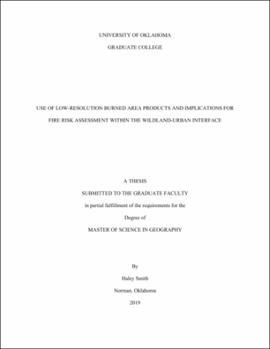| dc.contributor.advisor | de Beurs, Kirsten | |
| dc.contributor.author | Smith, Haley | |
| dc.date.accessioned | 2019-08-29T20:31:08Z | |
| dc.date.available | 2019-08-29T20:31:08Z | |
| dc.date.issued | 2019 | |
| dc.identifier.uri | https://hdl.handle.net/11244/321401 | |
| dc.description.abstract | The impacts of wildfires are socially, economically and ecologically vast and these impacts are often thought to be intensified within the wildland-urban interface (WUI) where structures intermingle with wildland vegetation. Because the WUI is expanding rapidly and ignitions within the WUI are said to occur more frequently, it is pertinent that fire scientists and land managers have access to accurate fire occurrence and burned area data within these regions. Burned area information is often accessed via remotely sensed burned area products of differing spatial resolutions. It is known that burned area products with coarse spatial resolution frequently underestimate burned area due to the omission of small fires; therefore, this thesis aims to explore how much burned area low-resolution BA products miss, where they miss burned area, and how different products detect burned area within the wildland-urban interface in Oklahoma, USA. In order to determine how much burned area is missed by these products and where the burned area is located in regards to the WUI, this project utilizes the MODIS MCD64A1 burned area product and the Monitoring Trends in Burn Severity (MTBS) data as a proxy for coarse-resolution burned area data and compares it to a higher-resolution dataset developed using Sentinel-2 imagery. We find that the low-resolution products are unable to detect a significant amount of burned area (Δ 57,000 acres) and may poorly depict the spatial distribution of fire as they were unable to detect major hotspots of fire occurrence. Additionally, we find that the majority of burned area within our study region (Eastern Oklahoma, USA) takes place outside of the WUI. | en_US |
| dc.language | en_US | en_US |
| dc.subject | burned area | en_US |
| dc.subject | remote sensing | en_US |
| dc.subject | wildland-urban interface | en_US |
| dc.subject | spatial resolution | en_US |
| dc.title | Use of low-resolution burned area products and implications for fire risk assessment within the wildland-urban interface | en_US |
| dc.contributor.committeeMember | Neeson, Thomas | |
| dc.contributor.committeeMember | Widener, Jeffrey | |
| dc.date.manuscript | 2019 | |
| dc.thesis.degree | Master of Science in Geography | en_US |
| ou.group | College of Atmospheric and Geographic Sciences::Department of Geography and Environmental Sustainability | en_US |
